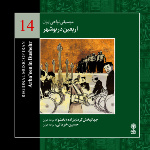
Songs
- artist:Jahânbakhsh Kordizâde & Hosseyn Khormâi'
- release year:2006
- style(s):Folk
- country:Iran
- formats:Audio File / Digital, CD (Compact Disc)
- record posted by:Mahoor Institute of Culture and Arts
- label:Mahoor Institute of Culture and Arts
- publisher:Mahoor Institute of Culture and Arts
- buy this record
Every year, the anniversary of the fourtieth day (Arba'een) of Emam Hosseyn's martyrdom, the grandson of Prophet Mohammad, is mourned officially throughout Iran. The city of Bushehr, an ancient port situated on the Persian Gulf, is renowned for its mourning rituals on this day.
Arba'een ceremony starts officially with the sounds and rhythmic display of seven dammâms, double headed drums, one side struck with a stick, the other with the fingers, seven cymbals and one bugh, a wind instrument reiterating a two note motif (c-f) on a certain rhythmic pattern. A 'Peeshkhân', literally 'one who sings before', arrives on the scene and begins singing nohe'(s), songs with religious texts, made up of rhymed verses of different lengths, dealing with various episodes of the martyrdom. Meanwhile, a circle of men, young and old, begings to form around him. Now, the principal soloist, singer of nohes, nohé khân, who has been waiting for more circle to take shape, enters the circle and stands in the centre while the peeshkhân leaves the scene. The nohekhân now begins the nohés, and the refrain is taken up by the circles; the singers of the circles have a more active and dynamic part to play than repeating the refrains, often entering in the midst of a hemistich and finishing the phrase, or often responding with certain dramatic ejaculations such as "vâ-vey-lâ", meaning "o woe". The texts, interestingly, deal mainly with Zeynab, Emam Hosseyn's sister, who arrives from Shâm for her brother's arba'een, and how she pours out her sorrow with the poetic images she uses to express her terrible grief. Her brother had been beheaded, and other members of her family cruelly slained in the tragic battle which took place in the fields of Karbalâ.


